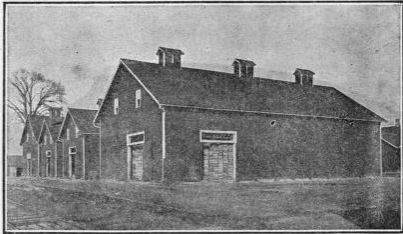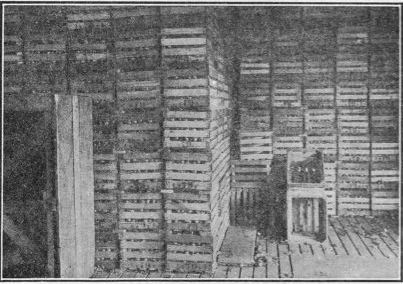541. Storing Onions
Description
This section is from the book "Vegetable Gardening", by Ralph L. Watts. Also available from Amazon: Vegetable Gardening.
541. Storing Onions
Onions should not be stored until thoroughly cured. Soft and immature bulbs and bulbs with thick necks should be sold when gathered, because they will not keep well. A bright appearance is an important characteristic of the most salable bulbs. To secure this the crop should not be exposed to the weather longer than absolutely necessary. The onions are usually kept in crates or bags, in sheds, or covered in the field, for several weeks, and then screened to remove loose skins before placing in permanent storage. At this time they are also sorted to remove soft or decaying onions.
The United States Department of Agriculture (U. S. D. A. Farmers' Bulletin 354, p. 25) gives the following information in regard to storing this crop: "The essentials for the successful storage of onions are plenty of ventilation, storing in small quantities, a comparatively low temperature, dryness, and safety from actual freezing. Any building wherein the above conditions may be secured will answer, but houses of the type shown in Figure 94, which are built especially for the purpose, are most satisfactory.
"The construction of the storage house should be double throughout, with plenty of felt or paper lining. Both top and bottom ventilation should be provided, and the ventilator openings should have windows that may be closed to control the temperature. The floors are constructed of narrow planks with 1/2-inch spaces between the planks for the passage of air. Bottom ventilation is frequently secured by means of drain pipes built into the foundation at the surface of the ground. These pipes are carried some distance toward the center of the house. They discharge the cool air at a point where it is most needed.

Fig. 94. onion storage house.
"The temperature of the storage house should be carried as low as possible without actual freezing. During extremely cold weather the ventilator openings and doors should be kept closed, to keep out cold, and after the onions have become thoroughly chilled the house should be kept closed in order to hold the temperature down and prevent the entrance of moisture during warm or rainy periods. Damp, foggy weather is injurious to onions, especially if it follows a period of cold, and will cause the bulbs to become covered with moisture if the outside air is admitted. A little artificial heat from a stove or a radiator may be required during excessively cold weather, but so long as the temperature in the house does not fall below 33 degrees there will be no danger of injury. A temperature of 34 to 36 degrees will give best results".

Fig. 95. onions stored in crates.
The crates previously referred to are 20 inches long, 16 inches wide and 14 inches deep, outside measurements. They are made of slats 3/8-inch thick and 2 l/2 inches wide, four pieces forming the side. The slats are nailed to three-cornered vertical pieces of oak at each corner on the inside of the crate. When stacked in the storehouses (Figure 95) 1 x 3-inch strips are placed between them, to permit free circulation of the air. Although bags and bins are also used in storing onions, neither are as satisfactory as crates, because they do not allow so free a circulation of air and the space cannot be used so economically.
Continue to:
Tags
plants, crops, gardening, cultivated, harvesting, food ,greenhouses, fertiliser, vegitables
